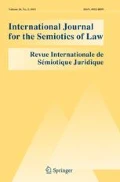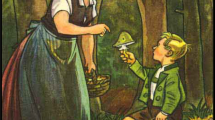Abstract
The jurisprudent Jack M. Balkin introduced the analogy of memes as a semiotic device for understanding the law. His notion of cultural software into which this device was inserted is developed first, followed by a development of memetic analysis and its several semiotic dimensions. After a brief treatment of the position of ideology in view of memetic analysis, and the corresponding notion of transcendence, Balkin’s explicitly semiotic setting for this doctrine is displayed. This method is then briefly applied to the civilian doctrine of patrimony, to supplement Balkin’s application of it to common law institutions.
Similar content being viewed by others
References
Alvarez, Asunción. 2004. Memetics: An evolutionary theory of cultural transmission. Sorites 15: 24–28.
Balkin, Jack M. 1987. Deconstructive practices and legal theory. Yale Law Journal 96: 743–876.
Balkin, Jack M. 1990. Nested oppositions. Yale Law Journal 99: 1669–1705.
Balkin, Jack M. 1993. Ideological drift and the struggle over meaning. Connecticut Law Review 25: 875–891; Previously published in 1991. In Action and agency. 4 th Roundtable on law and semiotics, ed. Roberta Kevelson. New York: Peter Lang.
Balkin, Jack M., and S. Levinson. 1994. Constitutional grammar. Texas Law Review 72: 1771–1804.
Balkin, Jack M. 1996. Interdisciplinarity as colonization. Washington & Lee Law Review 53: 949–970.
Balkin, Jack M. 1998. Cultural software: A theory of ideology. New Haven, CT: Yale University Press.
Balkin, Jack M. 1999. Free speech and hostile environments. Columbia University Law Review 99: 2296–2305.
Balkin, Jack M. 2001. Understanding the constitutional revolution. University of Virginia Law Review 87: 1045–1110.
Balkin, Jack M. 2004. Digital speech and democratic culture: A theory of freedom of expression for the information society. New York University Law Review 79: 199–223.
Balkin, Jack M. 2006a. Law and liberty in virtual worlds. In The state of play: Law, games, and virtual worlds, ed. Jack M. Balkin and Beth Simone Noveck, 86–119. New York: New York University Press.
Balkin, Jack M. 2006b. A night in the topics: The reason of legal rhetoric and the rhetoric of legal reason. In Law’s stories: Narrative and rhetoric in the law, ed. Peter Brooks and Paul Gewirtz, 211–224. New York: New York University Press.
Balkin, Jack M., and Sanford Levinson (eds.). 2000. Legal canons. New York: New York University Press.
Blackmore, Susan. 1999. The meme machine. Oxford: Oxford University Press.
Blackmore, Susan. 2002. A response to Gustav Jahoda. History of the Human Sciences 15 (2): 69–71.
Clark, Stephen R.L. 1996. Minds, memes, and multiples. Philosophy, Psychiatry, & Psychology 3 (1): 21–28.
Clark, Stephen R.L. 1993. Minds, memes and rhetoric. Inquiry 36 (1–2): 3–16.
Colopietro, Vincent M. 1997. Glossary of semiotics. New York: Paragon House.
Dawkins, Richard. 1982. The extended phenotype. Oxford: Oxford University Press.
Dawkins, Richard. 1976. The selfish gene. Oxford: Oxford University Press.
Dennett, Daniel C. 1991. Consciousness explained. Boston: Little Brown.
Dennett, Daniel C. 1990. Memes and the exploitation of imagination. The Journal of Aesthetics and Art Criticism 48 (2): 127–135.
Derrida, Jacques. 1977. Limited Inc abc. Glyph 2: 162–254.
Gadamer, Hans-Georg. 1975. Truth and method (trans: Garrett Barden and John Cumming). New York: Crossroad.
Gillett, Grant. 1999. Dennett, Foucault, and the selection of memes. Inquiry 42 (1): 3–23.
Ginossar, S. 1960. Droit réel, propriété et créance. Elaboration d’un système des droits patrimoniaux. Paris: Librairie général de droit et du jurisprudence.
Graham, Gordon. 2002. Genes. A philosophical inquiry. London: Routledge.
Gray, Christopher B. 1981. The notion of person for medical law. Revue de Droit de l’Université de Sherbrooke 11: 341–415.
Gray, Christopher B. 1981. Patrimony. Les Cahiers de Droit 22: 81–157.
Gray, Christopher B. 1982. Person and patrimony. Archiv fuer Rechts- u. Sozialphilosophie, Supp. I (1): 597–610.
Gray, Christopher B. 1999. Estate and patrimony. In The philosophy of law: An encyclopedia, vol. I, ed. Christopher B. Gray, 266–268. New York: Garland.
Greimas, Algirdas-Julien, and Joseph Courtès. 1979. Sémiotique: Dictionnaire raisonné de la théorie du language, vol. 1. Paris: Hachette.
Griesemer, James R. 1988. Genes, memes and demes. Biology and Philosophy 3 (2): 179–184.
Holdcroft, David, and Harry Lewis. 2000. Memes, minds and evolution. Philosophy 75: 161–182.
Jahoda, Gustav. 2002. The ghosts in the meme machine. History of the Human Sciences 15 (2): 55–68.
Jahoda, Gustav. 2002. A reply to Susan Blackmore. History of the Human Sciences 15 (2): 73–74.
Jeffares, Ben. 2005. Regaining archaeology’s nerve: Culture and biology in archaeological theory. Review of Genes, memes and human history: Darwinian archaeology and cultural evolution, by Stephen Shennan. Biology and Philosophy 20 (2–3): 545–556.
Lewontin, Richard C. 1970. The units of selection. Annual Review of Ecology and Systematics 1: 1–18.
Macdonald, Roderick A. 1994. Recovering the symbols of property: Universalities, interests and other heresies. McGill Law Journal 39: 760–802.
Martin, Bronwen, and Felizitas Ringham. 2000. Dictionary of semiotics. Cassell: London.
Morris, Charles. 1938. Foundations of the theory of signs. In Foundations of the unity of science: Toward an international encyclopedia of unified science, vol. 1, no. 2, ed. Otto Neurath. Chicago: The University of Chicago Press.
n.a. 1967. Rapports généraux au VII Congrès internationale de Droit comparatif (La transformation du patrimoine dans le droit civil moderne). Stockholm: Almquist and Wiksel.
Peirce, Charles S. 1906. Prolegomena to an apology for pragmatism. The Monist 16: 492–546. Reprinted in 1997. Collected papers of Charles Sanders Peirce, ed. Charles Hartshorne, Paul Weiss and Arthur W. Burks. London: Theommes Press.
Sprigge, Timothy. 1996. Commentary on “Minds, memes, and multiples” [Clark]. Philosophy, Psychiatry, & Psychology 3 (1): 31–36.
Sterelny, Kim. 1999. Dawkins’ bulldog. Philosophy and Phenomenological Research 59 (1): 255–262.
Sterelny, Kim. 2006. The evolution and evolvability of culture. Mind & Language 21 (2): 137–165.
Sterelny, Kim. 2006. Memes revisited. The British Journal for the Philosophy of Science 57 (1): 145–165.
Whitmeyer, Joseph M. 1998. On the relationship between memes and genes: A critique of Dennett. Biology and Philosophy 13 (2): 187–204.
Wimsatt, William C. 1999. Genes, memes and cultural heredity. Biology and Philosophy 14 (2): 279–310.
Statutes
Loi sur l’application de la réforme du code civil, L.Q. 1992, c. 57.




